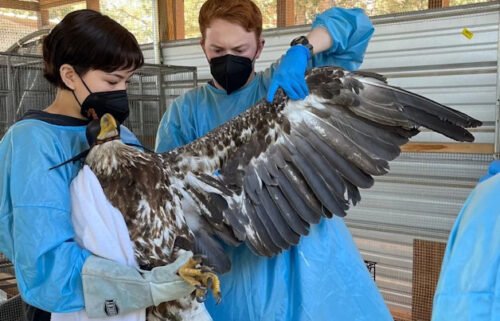Pole Creek Fire approaches full containment

The more than 2-week-old Pole Creek Fire reached 85 percent containment Thursday, the day after authorities finally lifted a pre-evacuation alert for areas south and west of Sisters.
Firefighters were able to get a line into the Three Sisters Wilderness on the
northwest corner of the fire Thursday, to slow fire spread, oficials said,
Meanwhile, crews continued mopping up on the east and southeast sides of the fire from Three Creek Meadow north.
Mop-up also continued along the west side of Trout Creek Butte strengthening line there.
The fire remains at 26,285 acres and is 85percent contained. Cloudy skies helped keep fire behavior low during the day on Thursday.
Plans for Friday were to continue mopping up, looking for spots and rehabilitating fire lines.
“Crews used aviation assets for a time on Wednesday afternoon along the northwest side of the fire to cool spots,” a Thursday morning update said.
After consulting with the Oregon Incident Management Team #4 (Blue Mountain Team), the sheriff’s office said Wednesday it was removing the Level 2 precautionary notice for Sisters-area residents (the Crossroads subdivision, Edgington, Remuda Road and the surrounding areas).
“Residents from the affected areas, and the Sisters community in general, should be mindful that fire conditions still exist and will likely continue until seasonal weather conditions finally change,” said Lt. Scott Shelton, search and rescue coordinator.
Shelton also reminded residents that a large area south and west of Sisters remains under a closure order, to insure the safety of firefighters as well as the public.
Fire officials said Thursday, “Residents are reminded that the fire is not out and they should monitor information sources for fire information.”
Two spot fires were discovered in the Trout Creek drainage and were contained on Tuesday, officials said, as warmer temperatures and light winds tested fire lines.
Helicopters dropped Thermagel, a class A retardant on the northwest corner of the fire to secure the line. Fire officials called Thermagel “a product that is safe to use in the wilderness (which) causes the water to stay ‘wet’ for a much longer period.”
The declining firefighting force, at 602 on Friday, encountered only moderate to low fire behavior, with occasional torching.
One helicopter was released on Tuesday evening and another was being released on Wednesday evening.
The fire spotted across the line west of Trout Creek Butte in several places on Saturday. But engines, bulldozers and hand crews established lines around all known spots by Sunday evening, totaling about 300 acres.
The fire also did not grow Tuesday, still reported at 26,285 acres.
Monday was the last night shift on the fire; all night-shift personnel will roll over into day shift, officials said.
Cooler temperatures Sunday and Monday helped keep fire behavior down, allowing
crews to make good progress on the lines.
But despite that, fire managers are being cautious in setting their first estimated date for full containment — Oct. 15, three weeks away.
A community fire information update was planned for Wednesday at 7:30 P.M. at the Sisters Elementary School at 611 East Cascade Ave. The briefing will include an in-depth update on the Pole Creek Fire.
For many High Desert residents, the weekend wind shift brought the most smoke-free skies in days if not weeks. By Monday morning, Bend’s air quality as measured by the DEQ was rated as good, and while Sisters remained in the unhealthy category, it was a major improvement from hazardous-level air reported in the early mornings last week.
The fire’s cause remains under investigation.
The National Weather Service dropped its Red Flag Warning for the region Sunday morning as the thunderstorm threat diminished.
While no lightning was reported in the area late Saturday, the wind did cause the fire to spot over the line on the west side of Trout Creek Butte.
A “surge task force” made up of two hotshot crews and a third crew was brought in to tackle the spot fires, officials said, and containment of those fires was a top priority for Sunday.
Before nightfall Sunday, dispatchers said crews had the spot fires lined.
Officials noted that secondary containment lines are in place, beyond the primary lines, as a precaution for spot fires and in case burnouts are needed to stop them.
Fire spokesman Ken Malgren said the spot fires, kicked up by winds related to storms moving through the area, were inside a secondary containment line on the north side of the blaze, burning well away from any populated areas.
“It was on the west side of the butte, got out along Trout Creek,” Malgren said.
The fire that broke out Sept. 9 six miles southwest of Sisters grew to cover over 40 square miles — bigger than the 32-square-mile city of Bend — though the growth has not pushed it closer than five miles from Sisters.
The cost of the battle has grown to $12.8 million, according to Tuesday’s National Interagency Fire Center report.
For more of the latest information from fire officials, visit the Pole Creek Fire’s InciWeb site.
Earlier information:
Air tankers returned to the skies over the fire on Tuesday for the first time in over a week, but much of the High Desert was choked with thick smoke.
The wind shifted Wednesday, giving much of Central Oregon another look at a towering smoke plume.
Firefighters used a combination of air tankers, helicopters engines and crews to keep the fire west of Road 16 (Three Creeks Road).
The large smoke columns late Tuesday developed when the main body of the fire grew together with burnouts on the southeast corner of the fire, in efforts to secure the southern perimeter.
Firefighters remain committed to keeping the fire west of Road 16, north of Tam McArthur Rim and Triangle Hill, and south of Millican Crater, they said.
Despite all that smoke, officials stressed that all highways remain open to Sisters and other Central Oregon communities.
They also said local forest officials had authorized the use of mechanized and motorized equipment such as chain saws, water pumps and air support on both the wilderness and non-wilderness lands.
Fire managers said four air tankers were ordered up and dropped retardant on the blaze Tuesday afternoon.
They had not been part of the battle since the first day of the fire, and fire officials said that was in part due to high demand for the retardant bombers on a number of major wildfires blazing across the Northwest.
The tankers made runs Tuesday afternoon on the south end of the blaze, “mainly to reinforce the containment line of the fire,” said spokeswoman Mary Ellen Fitzgerald.
“We didn’t request them every day,” she said, adding that the availability was checked late last Friday, the day the fire tripled in size amid hot, unstable conditions.
“The air tankers are a tool, just like helicopters,” Fitzgerald said. “You select the tool that’s best for the strategy you have that day.”
“You also need certain conditions to be able to bring them in, be it visibility, availability — are they around, are they on another fire?” Fitzgerald said. “We’re not going to put a fire out by lining it with retardant, typically. It’s a tool to help us — it retards the fire — and it can be a huge help,” under the right conditions.
The DEQ’s Wildfire Air Quality Index again showed Sisters air as “hazardous” – the worst air quality – early Tuesday while Bend’s air was labeled “unhealthy for sensitive groups.” Thursday morning again brought “hazardous” readings for Sisters but only “moderate” air quality in Bend.



